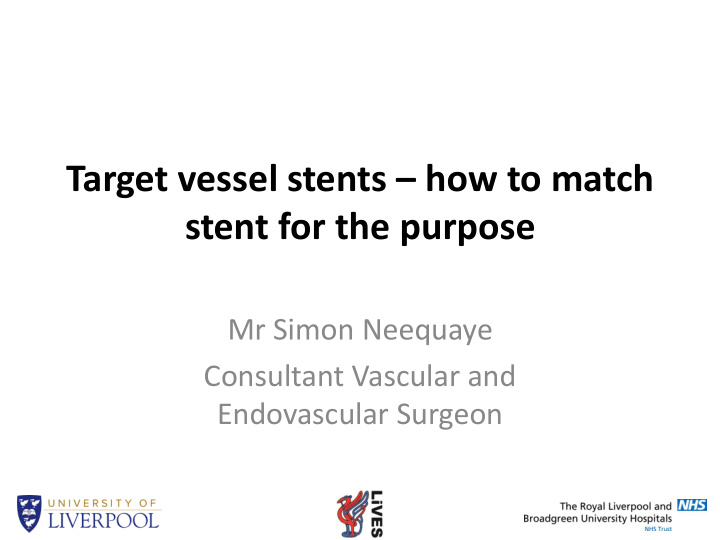



Target vessel stents – how to match stent for the purpose Mr Simon Neequaye Consultant Vascular and Endovascular Surgeon
Target Vessel Stents Maintenance of perfusion to visceral arteries with modular EVAR
Contained rupture-previous thoracoabdominal surgical • 64 yo female • Perfusion Snake to intercostals • Branch to CA from mid DTA
Chimney to CA Graft, T-Branch plus Bifurcated distally 9 x 59 Atrium
T-Branch
SMA and Right Renal 9 x 59 and 9 x 38 Atrium 7 x 59 plus 7 x38 Atrium
LRA – sacrificed as unable to track bridging stent-angle plus stenosis
Greatest Vascular Surgeon Ever!
• One hundred and fifty consecutive patients underwent f/bEVAR • The technical success rate 99% (520/523 target vessels). • Balloon expandable BSGs were mainly used 95% and in 65% relining stents were combined.
J Vasc Surg 2013;57:926-33. • 650 patients • 9 years followup • 30/1679 (1.7%) Branch stent occlusion • 30 day freedom from re-intervention 98% • 5 year freedom from re- intervention 89%
Long term failure modes- Target vessel stents • Endoleak, • Kink, • Fracture CA Stent • Migration perforation • Occlusion • Stenosis • Perforation. SMA stent dislocation
Control in an unstable world
Happy ending-1 • Graft Planning. – Prioritize stability in seal zone. – Consider Fenestrations for renals c.f Branches • Long term surveillance
Happy Ending-3 Choosing a Target Vessel stent- No stent is perfect! • Robust AND Flexible • Visible And Low profile • Available in a great range of sizes and be economical – Overdilation ( flare and in situ adjustment – Recanulation
Happy ending-3 • Pay special attention to stents that bridge space. • Atrium • Viabahn • Fluency
Happy ending-3 • Pay special attention to stents that bridge ? space. ? • Atrium • Viabahn • Fluency
Happy Ending! • Plan Aortic Graft carefully • Size bridging stent well • Use additional bare stents to manage transition or kinks. • Be wary of bridging space
Recommend
More recommend